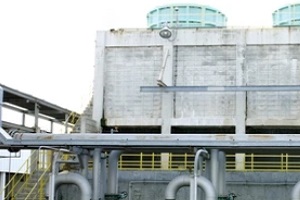 Cooling towers are common in commercial facilities, but their construction can vary. Choosing the right cooling tower for your operation will depend upon your facility’s needs, size, and environment. The right machinery for you will also be informed by your budget, your energy usage, and the tower’s location relative to the rest of your building. Make an informed decision by learning more about three of the most common cooling tower varieties.
Cooling towers are common in commercial facilities, but their construction can vary. Choosing the right cooling tower for your operation will depend upon your facility’s needs, size, and environment. The right machinery for you will also be informed by your budget, your energy usage, and the tower’s location relative to the rest of your building. Make an informed decision by learning more about three of the most common cooling tower varieties.
How To Categorize Cooling Towers By Design
You can distinguish between different cooling tower types based on how their system routes air. Remember—the purpose of a cooling tower is to remove excess heat from water passing through the system. The cooling tower passes air over the hot water so that the heat transferred into the air is swiftly carried away, thus reducing the water’s overall temperature.
Your facility may benefit from different air flow types depending on where you are located and how efficient you need your cooling to be, as well as how often you’re able to perform routine maintenance.
Cooling Towers That Utilize Crossflow
Crossflow cooling towers are common due to their ease of maintenance. “Crossflow” refers to how air flows through the system. Water that cascades down to the crossflow tower’s collection basin interacts with airflow as it evaporates the water in a horizontal direction.
Although this type of system can be expensive to install, it is easy to manage—although businesses in cold regions should pay extra attention to their machinery. Crossflow cooling towers are made from materials that make them susceptible to frost damage.
Counterflow Cooling Towers
Compared to crossflow cooling towers, counterflow tower designs reverse the air pathway. As water descends to the basin, air is propelled upward so that it flows counter to the direction of the water.
This is where the term “counterflow” comes from—the air is moving counter to the direction of the water in order to remove heat through evaporation. This type of system uses more energy and can lead to higher utility costs. For those who need a more compact cooling tower system, counterflow options may be the right choice despite the higher utility costs.
Hyperbolic Cooling Tower Designs
Hyperbolic designs are less common than counterflow or crossflow cooling towers, but they’re worth consideration for their robust water-processing power alone. Hyperbolic towers employ the natural properties of air—that hot air rises and cool air descends—to reduce the amount of resources required to cool your water.
Contact The Water Treatment Pros
To learn more about Tower Water's services reach out today!
These systems use a chimney stack-like feature to direct cool outside air in a pattern that expels warm air from the tower. Because much of this process is natural, hyperbolic towers use less energy and are more affordable over the long term. However, their large scale makes them a better option for spacious facilities.
Which Type Of Tower Is Best For You?
Your facility’s needs and goals will inform the type of cooling tower that is right for you. Hyperbolic cooling towers are very large but their relative efficiency contributes to their longevity. Still, you may not have adequate space for such a sizable cooling tower.
You might consider a crossflow tower, but if you live in an area with colder temperatures and frequent frost, your crossflow tower may struggle against the weather for most of the year. Any tower recommended to you should be based on a customized plan made for your specific facility, which is where an expert can be of use.
Trust The Experts To Help You Choose And Maintain The Ideal Cooling Tower
Whether you are replacing your current tower or installing one for the first time, you do not need to make this decision without expert oversight. The professionals at Tower Water would be happy to help you find the right tower for your needs. Reach out to learn more or to schedule an appointment to get started.
